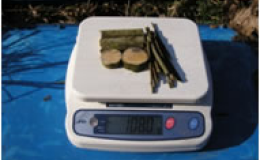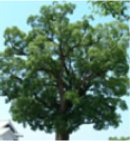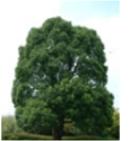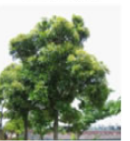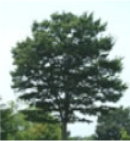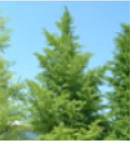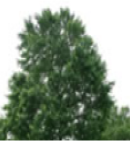Trees grow large by fixing atmospheric carbon dioxide (CO2) absorbed through photosynthesis in the form of cellulose in their bodies. On the other hand, it is known
that 50% of the dry weight of the trunk, branches, and roots of a tree is the weight of carbon (C), all of which is derived from CO2 absorbed from the atmosphere
through photosynthesis.
From this, by determining the dry weight of the entire trunk, branches, and roots of a single tree, it is possible to estimate the amount of CO2 fixed by the tree
during its growth. Furthermore, by measuring and comparing the dry weight and age of multiple trees of the same species at different ages, it is possible to estimate
how much each tree grows in one year and how much CO2 it fixes in one year.
The National Institute for Land and Infrastructure Management (NILIM) used this approach to obtain a formula for calculating annual CO2 fixation.
Let's calculate the annual CO2 fixation!
Use the annual CO2 fixation formula to measure the amount of CO2 fixed by trees around you in a year!
Enter the diameter of the trunk (diameter at breast height)
or the age of the tree at 1.2 m from the ground and click the Calculate button.
all trees
(The equation was calculated using data from camphor trees, Japanese white oaks, Japanese maples, zelkova trees,
ginkgo trees, platanus species, and cherry trees.)
Range of trees used to create this calculation formula
Diameter at breast height: 9 to 66 cm
Age of trees: 9 to 52 years
Background
- Global warming is currently a major issue.
-
To reduce CO2, a major component of greenhouse gases, it is necessary to
(1) reduce emissions
(2) Increase absorption and fixation by plants.
- As one of the measures to combat global warming, urban greening plays an important role in promoting the measures to absorb (2) in urban areas.
Objective
-
In order to quantitatively clarify the effectiveness of urban greening as a sink measure for global warming, it is necessary to determine the amount of CO2 fixed by
trees. (Urban greening also has other benefits, such as mitigating heat islands and reducing the use of air conditioning.)
- There is a need to develop a calculation method that can be used in the Kyoto Protocol report and other documents.
-
To this end, we will create a formula for calculating CO2 fixation for urban greening trees (trees that are planted in large numbers in cities) that
reflects the growth characteristics of trees in Japan.
Methods
- CO2 fixation target: Trunks, branches, and roots (long-term fixation continues when converted to wood)
- (1) Find the total live weight of the tree
-
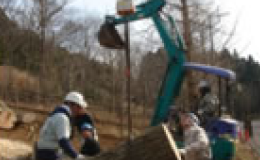
The above-ground parts (trunk and branches) are felled and the total live weight is measured.

The underground portion (roots) is dug up to the extent of root elongation and the total live weight is measured.
- (2) Find the fresh to dry weight ratio of trees
-
-
Samples are taken from the trunk, branches, and roots, and after measuring the fresh weight, they are dried in a dryer to determine the dry weight.
The total
dry weight of the woody part is obtained from the ratio of the fresh to dry weights of the samples.
- (3) Relative growth equation between breast height diameter and dry weight of woody parts
-
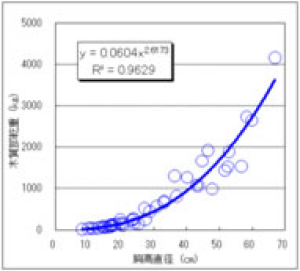
Since it is generally known that
a relative growth equation Y=aX ...... Equation
(where a and b are constants)
can be established between the weight of each organ of a tree (Y) and the shape dimension of the tree (X), we obtain a relative growth equation that
approximates the distribution of points on a graph of total dry weight of woody parts versus breast height diameter.
- (4) Linear regression equation between breast height diameter and tree age
-
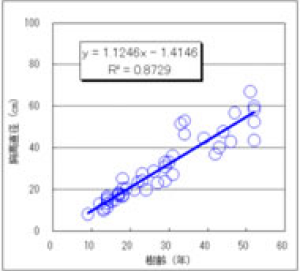
The relationship between age (X) and breast height diameter (Y) for each tree in the studied area showed an almost constant amount of increase, which led to
a linear regression equation Y=cX+d.......Equation 2
(c and d are constants)

- (5) Create a formula for calculating annual wood dry weight growth
-
Annual woody dry weight growth (Y) is the difference between the woody dry weight at breast height diameter (X) and the woody dry weight at breast height diameter
(X+c) with the addition of the annual increase (c), which can be expressed by the following formula.
- Y=a(X+c) -aX =a{(X+c) -X } .....Equation 3
-
Y : Growth of dry weight of woody parts per year
X : diameter at breast height
a,b:Constant obtained from the relative growth equation in Equation 1
c : Annual growth in breast height diameter obtained from the regression equation in Equation 2
- (6) Creation of formula for calculating annual fixed amount of CO
-
The carbon (C) content of the woody part is about 50% of its dry weight.
→Multiplying equation 3 by 50% gives the annual amount of carbon fixed.
The
ratio of the molecular weights of CO2 and C is 44:12.
→The annual amount of carbon sequestration can be converted to CO2 sequestration by multiplying the
annual amount of carbon sequestration by 44/12.
- = Formula for calculating annual fixed amount of CO
- Example: All trees
-
Y = 0.111 {(X+1.1)2.6173 - X2.6173}
Y : Annual CO2 fixed amount (kg)
X : Diameter of chest height (cm)
References
- Matsue M., Nagahama Y., Iizuka Y., Murata M., Fujiwara N. (2009).
- Estimation equations for the amount of CO2 fixed by planted trees in cities in Japan.
- Journal of the Japanese Society of Revegetation technology,35(2) : 318-324.




